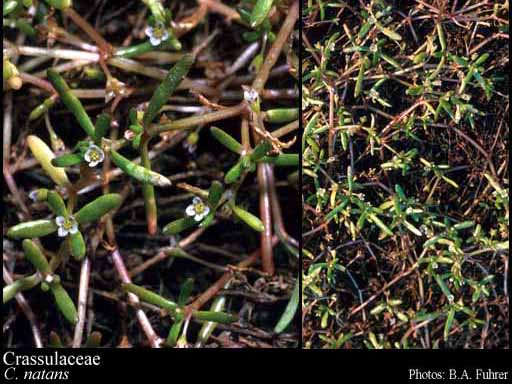- Reference
- Expos.Fam.Nat. 2:123 (1805)
- Name Status
- Current







Scientific Description
Common name. Stonecrop Family.
Habit and leaf form. Herbs, or shrubs (or ‘treelets’); evergreen. Plants succulent. Perennial; plants with a basal concentration of leaves, or with neither basal nor terminal concentrations of leaves. Xerophytic (mostly), or mesophytic, or hydrophytic (rarely). Leaves alternate, or opposite, or whorled; when alternate, spiral; fleshy; petiolate; non-sheathing; simple; peltate (sometimes), or not peltate. Leaf blades entire (usually), or dissected (e.g. sometimes in Bryophyllum, Kalanchoe); flat (more or less), or solid; when dissected, pinnatifid; one-veined, or pinnately veined; cross-venulate, or without cross-venules. Leaves without stipules. Leaf blade margins entire, or crenate, or serrate. Leaves without a persistent basal meristem. Leaf anatomy. Hydathodes commonly present. Stem anatomy. Nodes unilacunar, or tri-lacunar. Secondary thickening mostly developing from a conventional cambial ring (very occasionally ‘anomalous’).
Reproductive type, pollination. Fertile flowers hermaphrodite. Unisexual flowers absent. Plants hermaphrodite (usually). Floral nectaries present. Nectar secretion seemingly from the gynoecium (each carpel with a nectariferous appendage abaxially near the base, these usually in the form of scales, but large and petaloid in Monanthes). Entomophilous.
Inflorescence and flower features. Flowers solitary, or aggregated in ‘inflorescences’; in cymes, or in corymbs. The terminal inflorescence unit cymose. Inflorescences cincinni or corymbs. Flowers small to medium-sized; very regular; (3–)5(–30) merous; cyclic; pentacyclic. Floral receptacle not markedly hollowed. Free hypanthium present (the flower usually weakly perigynous). Hypogynous disk seemingly absent (i.e. the nectariferous appendages being interpreted as gynoecial). Perianth with distinct calyx and corolla; (6–)10(–60); 2 -whorled; isomerous. Calyx (3–)5(–30); 1 -whorled; polysepalous; imbricate; regular; persistent. Corolla (3–)5(–30); 1 -whorled; polypetalous (usually), or gamopetalous (basally); imbricate; regular; white, or yellow, or pink, or purple. Androecium (3–)5(–30). Androecial members free of the perianth, or adnate (to the corolla tube/hypanthium); free of one another (usually), or coherent (basally); when connate, 1 - adelphous; 2 -whorled (usually), or 1 -whorled. Androecium exclusively of fertile stamens (usually), or including staminodes (e.g. some Sempervivum species). Stamens (3–)5(–30); diplostemonous (usually), or isomerous with the perianth (occasionally); alternisepalous (when 2 whorled), or oppositisepalous (when one whorled). Anthers more or less basifixed; non-versatile; dehiscing via longitudinal slits; latrorse (to slightly introrse), or introrse (Crassula); bilocular; tetrasporangiate. Gynoecium (3–)5(–30) carpelled. Carpels isomerous with the perianth. Gynoecium apocarpous; eu-apocarpous to semicarpous (the carpels often slightly united at the base); superior. Carpel apically stigmatic (the style short or long); (1–)5–50 ovuled (usually ‘many’). Placentation (sub) marginal. Stigmas wet type; papillate; Group III type. Ovules pendulous to horizontal; biseriate; non-arillate; anatropous.
Fruit and seed features. Fruit non-fleshy; an aggregate. The fruiting carpels not coalescing (usually), or coalescing into a secondary syncarp (this a capsule, in Diamorpha). The fruiting carpel dehiscent; a follicle. Seeds endospermic. Endosperm oily. Cotyledons 2. Embryo achlorophyllous (2/4); straight. Seedling. Germination phanerocotylar.
Physiology, biochemistry. Aluminium accumulation not found. Photosynthetic pathway: CAM.
Geography, cytology, number of species. World distribution: very widespread, but mainly in warm dry regions - especially in Southern Africa. 1500 species.